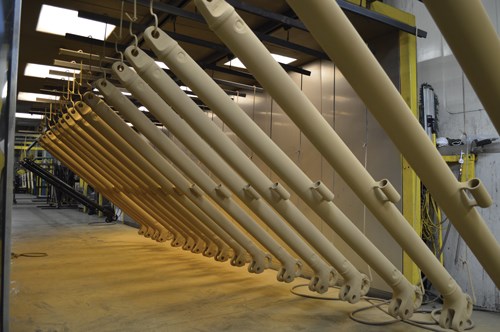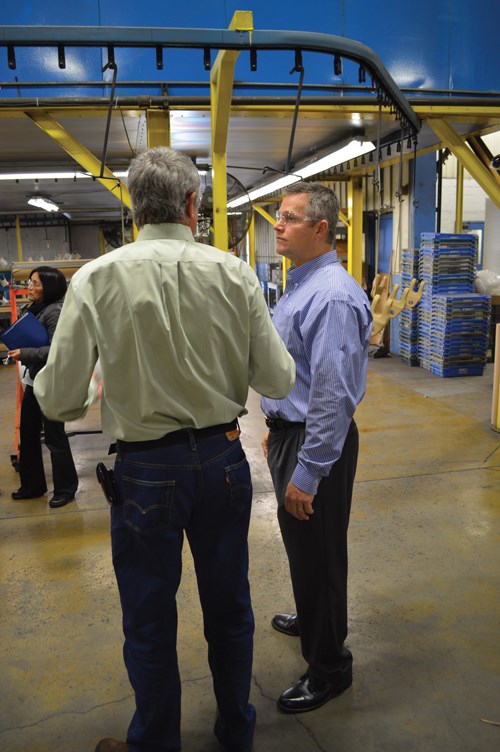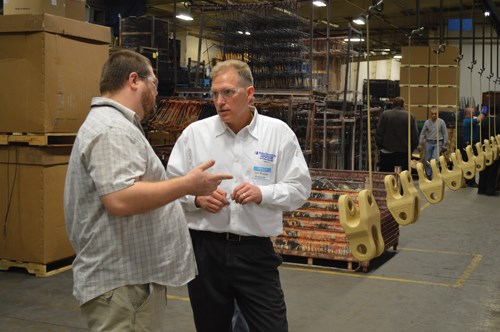Game Changer: Powder Coatings Get CARC Approval
In a normal R&D scenario, a coating specification is written and approved by a large customer or OEM, then followed by a race among suppliers to meet the spec and sell to the finishing masses. But that isn’t the case for most of the military and other finishes Hentzen Coatings of Milwaukee, Wisc., has developed over the years.
In a normal R&D scenario, a coating specification is written and approved by a large customer or OEM, then followed by a race among suppliers to meet the spec and sell to the finishing masses.
But that isn’t the case for most of the military and other finishes Hentzen Coatings of Milwaukee, Wisc., has developed over the years.
“The original CARC spec was written around technology that we developed. Since then, many of the revisions to the specs have also been driven by technology developed by Hentzen Coatings, Inc.,” says Mike Hentzen, vice president of sales and marketing, whose family has run the company for 90 years.
Hentzen Coatings—which claims it is the largest supplier of chemical agent resistant coatings products to the U.S. Army—announced that it received from the military the first-ever approval of a CARC powder topcoat per MIL-PRF-32348 Type III.
The approval marks a dramatic game changer for the powder coating industry, which has seen the paint industry get far more military contracts over the past two decades because of its CARC applications.
CARC Topcoat Spec
When the military announced in 2012 that it would pursue a powder CARC topcoat spec, it signaled a chance for the powder coating industry to score more revenue and opportunity than in the past.
That is one of the reasons Hentzen Coatings so heavily invested its research labs in the powder CARC arena.
“If you look at the changes to the CARC specs in the last decade, many of those changes were driven by newer, lower-VOC products developed by Hentzen Coatings,” Hentzen says.
Jay Burkard, president of Burkard Industries in Detroit, was excited to have Hentzen show off its new CARC products in his shop, which supplies a lot of parts to the military. Burkard believes adding a CARC powder topcoat over an ecoat primer is a superior coating system when compared to any of the current military coating options.
“Some of these advantages include increased corrosion protection, less technical skills required for the workforce due to easier application and no paint mixing, less scuffing and scratching of finished goods during transport, and lower application costs due to higher line throughput,” he says.
Burkard's company has been working with Hentzen since 2009, and he knows firsthand the company's R&D prowess.
“It does not surprise me that they are the first paint manufacturer to develop an approved CARC powder coat,” he said. “This is another example of Hentzen’s strong technical knowledge.”
Hentzen Coatings developed and qualified a powder primer for use with CARC systems as early as 2003, and the R&D for the powder topcoat was initiated by the company well before there was any real discussion by the Army on developing a spec. Hentzen said that the progress made by Hentzen Coatings was one of the factors that propelled the U.S. Army Research Lab (ARL) to issue the MIL-PRF-32348 specification for the topcoat.
The ARL has also faced increased pressure from the U.S. Environmental Protection Agency, which wants the military to use coatings free of volatile organic compounds, volatile organic hazardous air pollutants and inorganic hazardous air pollutants.
Advantages of Powder
“There are many advantages to allowing powder coating to be a part of the program,” John Escarsega, DoD CARC commodity manager for the coatings team at Aberdeen, said at the time of the specification release.
“Environmental is a big reason, but there is also some reduced costs we should be seeing,” he said. “It’s a good step forward.”
The specification for primer and topcoat calls out four types of coatings:
Type I coating: an epoxy-based primer CARC.
Type II coating: an epoxy-based primer for interior components CARC.
Type III coating: camouflage top coatings CARC; primary colors required by the ARL are 383 green, 686 tan, aircraft green, black and brown.
Type IV coating: coatings for ammunition containers.
John Mort, Hentzen Coating’s sales manager for defense products, says it was around 2006 when the company’s research labs began heavily working on developing the MIL-PRF-32348 Type III topcoat.
The project was difficult because of the DoD's challenging requirements for the CARC topcoat, especially as it related to protecting the troops using vehicles in the battlefield.
Decreasing Gloss
The spec requires that the topcoat be highly chemical resistant and lusterless, meaning it has to measure below 1.5 units of gloss. The coating also has to have a defined infrared reflection as well as provide advanced weathering properties.
While traditional powder coatings can be formulated to meet many of the spec requirements, their performance in certain areas is hampered when the gloss is reduced to levels required for camouflage CARC: no greater than one unit of gloss at 60˚F, and no greater than 3.5 units of gloss for green and 4.0 units for tan at 85˚F.
“The toughest part was getting to low gloss while still maintaining all of the other performance properties, particularly the CARC protection that we needed,” Mort says.
But solving coating issues—often before many in the industry even realized there was a need—has been the hallmark of the company since brothers Herbert and Erwin Hentzen secured financial backing from their father, Albert, and started Wisconsin Paint Manufacturing in 1923 in a renovated toy factory.
As the advance of the automotive industry paralleled a growing need for coatings and paints, the Hentzen brothers—both of whom had advanced degrees in chemical engineering—realized the paint industry would go further if it more synthetics were used in production rather than linseed oil and turpentine.
The Hentzens’ research lab began churning out new coatings made with synthetic pigments and solvents, and they grabbed a major share of the industry. The company scored big when the brothers came up with a solution for coating diesel engines and became well-known across the U.S. manufacturing sector for being able to solve complex coating issues in their highly sophisticated labs.
WWII Honorees
With World War II as a backdrop, the Hentzens worked closely with the U.S. military on new camouflage coatings for vehicles and equipment, winning praise for their scientific research and cutting-edge technology. The U.S. Army Ordinance Award for Outstanding Contribution was given to Wisconsin Paint in 1944, one of only two awards presented by the Army to members of the coating industry.
Herbert’s three sons, Herbert Jr., William and Albert, all started working for the company in the 1950s. In the late 1960s, the company changed its name to Hentzen Chemical Coatings, which was officially shortened to Hentzen Coatings in 1982.
In 1994, Hentzen Coatings started its first line of powder coating products at about the same time Albert Hentzen, grandson of the founder, bought out his two brothers and put more R&D into powder coatings with a new facility on Mill Road in Milwaukee to meet the growing demand.
The fourth generation of Hentzens joined the company at the start of 2000, as Albert’s sons Steven and Michael graduated from law school and went to work for the business. Another son, Timothy, joined the company in 2005 after college, and soon the Hentzens were looking at further expansion.
They purchased the aerospace products division of Adheron Coatings in Oak Forest, Ill., in 2003 and moved its production and research operations to Milwaukee; the next year they purchased BASF’s container and pipe coating business as well as a facility in Illinois, giving it an 80,000 square foot R&D lab and manufacturing facility.
Acquisitions
After building an additional 80,000 square foot facility at its Milwaukee headquarters in 2008, Hentzen Coatings continued to look for acquisitions. The company purchased Axon Products in South Carolina to broaden its aerospace and wood finishing product lines, and in February 2013 acquired Crosslink Powder Coatings in Florida, including laboratories and production facilities in Clearwater.
Albert Hentzen, who still serves as president and CEO of Hentzen Coatings, says the Crosslink acquisition will be critical to his company’s growth strategies, especially because it adds architectural powders to its product range.
“In addition to adding a new segment to our business, we will take immediate steps to grow the capacity of the Clearwater plant to help us meet growing powder coatings demand,” he says.
All totaled, Hentzen’s footprint includes its 225,000 square foot Milwaukee facility, where it houses its corporate offices, liquid/powder production facilities and a distribution center; liquid manufacturing locations in Batavia, Ill., and Greenville, S.C.; and its new powder coating manufacturing facility in Clearwater, Fl.
However, despite all the history between Hentzen Coatings and the military, it was two other powder coating manufacturers that received large grants from the DoD to research and develop a suitable CARC topcoat.
ARL Contracts
In 2012, Sherwin-Williams was awarded a $1.4 million research grant to develop a zero-VOC, zero-hazardous air pollutant exterior powder topcoat by 2015. The company was the first to release a zero-VOC epoxy primer qualified to the MIL-DTL-53022 Type IV specification.
Then, in January 2013, PPG Industries received a $1.5 million award from the federal government’s Strategic Environmental Research and Development Program to develop a CARC powder topcoat. The company already is qualified by the ARL as a producer of powder primer for CARC systems.
Mike Hentzen says his company prefers to go it alone in its R&D efforts as they pertain to CARC.
“We’ve always done it independently using our own resources to develop our own products,” he says. “It allows us to have free reign on how we want to work. Sometimes you are never too sure what things are attached to those grants.”
Mort says that whether Hentzen Coatings is part of the Army’s CARC research program is not an inhibitor to continuing the company’s own efforts to find a solution.
“We have always been in the CARC market, which means we are always looking at ways to develop products for that market,” he says. “Basically, we are always looking for products that our customers want to use, and we are funding that on a daily basis.”
R&D Push
Hentzen Coatings has about 30 full-time personnel devoted to continuously developing new coatings products. The research teams, which make up about 15 percent of the entire workforce, are organized around the markets the company serves—defense, aerospace and general industrial—to better facilitate speed-to-market and product launches.
“The focus is maintaining the products we are already selling and making them even better,” Mike Hentzen says. “But obviously we are looking at new ways to serve our customers. We have to give them what the market requires.”
Hentzen Coatings has been visiting numerous customers over the past few months to fine-tune the application process of the new CARCs. Part of that program is demonstrating proper mechanics of application and working with customers on integrating the products into their systems.
Customer Demand
“Part of the effort is to make sure the process is well-defined with our customers,” Mort says. “It’s basically just like re-teaching the CARC painting process, because it uses new materials that traditionally are not part of military painting. There will be a learning curve for everyone.”
But there is no question that powder coaters are chomping at the bit to get a piece of the CARC market sector.
“They are lined up out the door to get this stuff,” Mort says.
Hentzen Coatings also recently announced it was starting Hentzen de Mexico, based in Queretaro, Mexico.
“We are very excited about the potential of the Mexican market,” Mike Hentzen says. “We feel confident that the launch of Hentzen de Mexico, supported by local sales and technical staff and a stocking point in the heart of the country’s industrial sector, will enable us to accelerate our growth in this market.”
What’s Ahead
Hentzen Coatings has also recently patented a zero-VOC CARC topcoat that is a water-based, water-reducible product that Mort says addresses disadvantage issues with the MIL-DTL-64159 spec.
“Instead of a three-component, it is a two-component system that dries faster than the current single-component system and is water-reducible,” he says. “Plus it has zero VOCs. We are testing it now, and we want to move it forward as quickly as possible.”
And what will happen when Hentzen Coatings' scientists say they have formulated the process and green-light the product to go to market?
“It is a unique product. They may have to write another a spec around it,” Mort says.
For information on Hentzen Coatings, call 414-353-0286 or visit Hentzen.com.
Related Content
High Temp Alignment Masking Discs
Designed with printed alignment “target” rings for easy application, PCX-SH Series powder peel green discs from Caplugs ensure pinpoint accuracy when centering over any hole.
Read MoreEPSI Relaunches Custom Masking Program
EPSI’s plotter cutting provides custom solutions for complicated masks and irregular shapes.
Read MoreMasking Solutions for Medical Applications
According to Custom Fabricating and Supplies, a cleanroom is ideal for converting, die cutting, laminating, slitting, packaging and assembly of medical-grade products.
Read MorePowder Coater Leverages Its Manufacturing Mindset for Success
As a former motorcycle manufacturer, this powder coating Top Shop benefits from understanding the finishing industry from a customer’s perspective.
Read MoreRead Next
Battle for CARC Powder Coating
Sherwin-Williams and PPG were awarded research grants by the Department of Defense in June 2012 to develop a zero-volatile organic compound, zero-hazardous air pollutant exterior topcoat to replace the military’s current generation of liquid-applied chemical agent resistant coatings (CARC) by 2015.
Read MoreDelivering Increased Benefits to Greenhouse Films
Baystar's Borstar technology is helping customers deliver better, more reliable production methods to greenhouse agriculture.
Read MoreA ‘Clean’ Agenda Offers Unique Presentations in Chicago
The 2024 Parts Cleaning Conference, co-located with the International Manufacturing Technology Show, includes presentations by several speakers who are new to the conference and topics that have not been covered in past editions of this event.
Read More

























